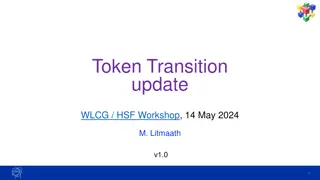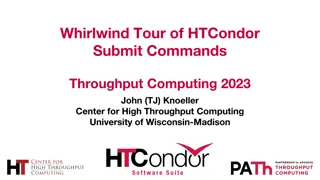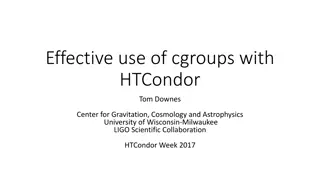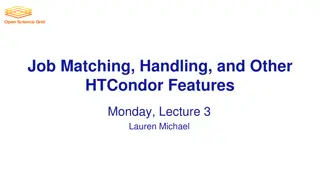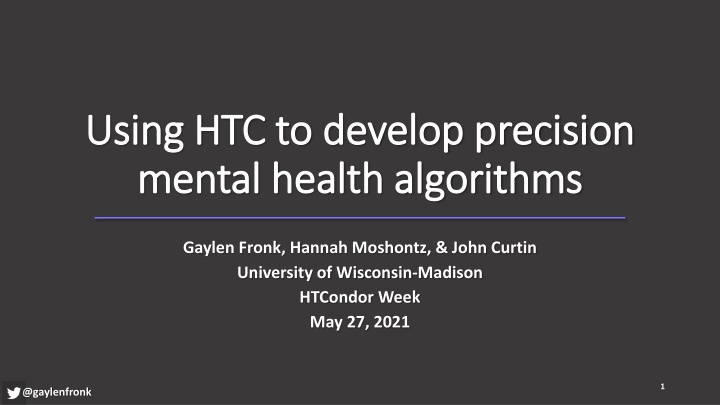
Precision Mental Health Algorithms Development Using HTC
Explore the application of precision medicine in mental health utilizing HTC for developing algorithms to enhance treatment effectiveness. Dive into machine learning, model fitting, and statistical algorithms to personalize mental health interventions and improve outcomes.
Download Presentation

Please find below an Image/Link to download the presentation.
The content on the website is provided AS IS for your information and personal use only. It may not be sold, licensed, or shared on other websites without obtaining consent from the author. If you encounter any issues during the download, it is possible that the publisher has removed the file from their server.
You are allowed to download the files provided on this website for personal or commercial use, subject to the condition that they are used lawfully. All files are the property of their respective owners.
The content on the website is provided AS IS for your information and personal use only. It may not be sold, licensed, or shared on other websites without obtaining consent from the author.
E N D
Presentation Transcript
Using HTC to develop precision Using HTC to develop precision mental health algorithms mental health algorithms Gaylen Fronk, Hannah Moshontz, & John Curtin University of Wisconsin-Madison HTCondor Week May 27, 2021 1 @gaylenfronk
Background: Traditional Treatment Assignment Background: Traditional Treatment Assignment 75% Effective 25% Effective 2 @gaylenfronk
Background: Precision Mental Health Background: Precision Mental Health The application of precision medicine to mental health conditions Goal: to use individual differences to select the treatment with the highest predicted treatment efficacy for a given patient 1. Increase likelihood of treatment success within an individual 2. Improve treatment effectiveness rates across the population 3 @gaylenfronk
Background: Machine Learning Background: Machine Learning Offers a path forward for precision mental health Maps onto complexity of people and clinical phenomena Prioritizes out-of-sample prediction 4 @gaylenfronk
Model Fitting Model Fitting Models include: Treatment condition ~400 individual difference predictors Outcome (treatment success at 6 months) Data used for model fitting Data used for model evaluation 5 @gaylenfronk
Model Fitting Model Fitting Model configurations include: Statistical algorithms (e.g., elastic net logistic regression, random forest, k- nearest neighbors, neural networks) Algorithm-specific characteristics (e.g., hyperparameters, number of hidden layers) Feature sets & feature engineering decisions 6 @gaylenfronk
Model Fitting Model Fitting Example: Statistical algorithm: random forest Algorithm-specific characteristics: 3 hyperparameters with varying levels, total of 100 combinations Feature sets & feature engineering decisions: models with self-report items or self-report scales Total: 200 models to fit 7 @gaylenfronk
Jobs Setup Jobs Setup To maximize parallelism of CHTC, we break down model fitting into the smallest jobs possible Single combination of statistical algorithm, algorithm characteristics, and feature characteristics run as one job Jobs are run across CHTC and Open Science Grid machines We aggregate jobs locally to select the model configuration that performed best across cross-validated iterations 8 @gaylenfronk
Computing Time Computing Time Each model takes anywhere from 1 5 minutes to run Even running in parallel locally, it would take days to fit single scenarios This is ~650 computing hours just for the previous example scenario! Computing time multiplied by intended scenarios as well as testing and iteration 9 @gaylenfronk
Using CHTC & Using CHTC & HTCondor HTCondor Most important feature is the CHTC support team! Also helpful are clear documentation and walkthroughs Have also benefitted from within-lab collaboration across multiple projects using CHTC 10 @gaylenfronk
Impact Impact Precision mental health research and algorithm building will only be possible with this kind of computing power Allows me to maximize time, resources, and person power Allows me to expand my research and funding opportunities Incorporating genetics UW Seed Grant Fellowship application 11 @gaylenfronk
Thank you! 12 @gaylenfronk

